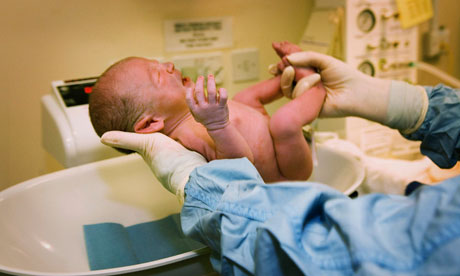NHS faces £85.8m compensation bill over maternity blunders
Cost of settling lawsuits where a baby's heart rate scan was misinterpreted has increased more than seven-fold since 2006

Newborn baby in a NHS maternity unit. Campaigners say urgent action is needed to improve safety during childbirth. Photograph: Christopher Furlong/Getty Images
The NHS is facing a spiralling bill for blunders made by maternity-unit staff during labour that result in a baby dying or suffering brain damage or disability, the Guardian can reveal.
The cost of settling lawsuits in which a midwife or obstetrician has misinterpreted a cardiotocogram (CTG) scan of a baby's heart rate has risen from £11.8m in 2006 to £85.8m last year, according to new figures collated by the NHS Litigation Authority (NHSLA), a more than seven‑fold increase.
The huge increase in damages reflects improved knowledge of a brain-damaged baby's lifetime care needs, as well as an increase in the number of cases settled, from 26 to 36. All involved the alleged misinterpretation of a CTG trace, which is a common way of monitoring a baby's health while its mother is in labour.
Doctors and patient safety campaigners said the figures underline the need for urgent action to tackle what they called a recurring mistake that leads to preventable tragedy. Midwives and obstetricians need better training in order to improve their knowledge of what should be a fundamental skill of their job, they said.
Dr Edwin Chandarahan, an obstetrician and expert in CTG errors at St George's hospital in south London, said that while CTGs were hard to read, maternity staff were making too many mistakes. About 500 babies a year die because of this problem, and an unknown number of others suffer brain damage, such as cerebral palsy, he said.
The NHSLA, which defends hospitals in England against clinical negligence claims, paid out a total of £196.8m in settling 130 such cases between 2006 and 2010. In 78 cases the baby died, while in 43 the baby developed cerebral palsy as a result of being deprived of oxygen due to a CTG mistake.
The NHSLA did not indicate whether the mistake in each case was by a midwife or obstetrician, or both. But in a 2009 report into the problem of stillbirths it found that, from a sample of 100 such cases, 39 involved a CTG error – 25 by midwives, eight by a registrar or senior registrar and four by a consultant obstetrician.
The NHSLA is also processing 87 ongoing claims in which £319.4m in damages are being sought. But this is likely to be a serious underestimate, as solicitors told the Guardian that they had almost 400 such cases pending.
Auriana Griffiths, a medical negligence solicitor at Irwin Mitchell who specialises in childbirth cases, said 13 of her ongoing 18 obstetric lawsuits against hospitals involved CTG errors, according to independent medical experts. "This is a major problem and there does not appear to be any sign that lessons are being learned from the mistakes. In my experience the same problems are occurring again and again, with catastrophic results.
"Families affected by negligent treatment have to walk away from hospital after giving birth to a child who should have been born perfectly healthy but ended up with severe brain damage. I know that we are all only human and mistakes are made, but we have to do what we can to try and reduce the number of catastrophic mistakes", said Griffiths.
Childbirth campaigners claimed the figures showed that problems with reading CTGs were an ongoing scandal that blighted NHS maternity care. Judy Ledger of the mother and baby charity Baby LifeLine said that CTG errors were a key element of "continuing substandard maternity care that is leading to preventable deaths". Maternity staff needed greater education and training, she added.
Peter Walsh, chief executive of the patient safety charity Action against Medical Accidents, said: "It is particularly galling to us that we continue to see problems with CTG monitoring resulting in serious avoidable injuries to babies. It is a problem we have been seeing for over 20 years and it should have been addressed by now."
Midwives' and obstetricians' leaders acknowledged that action is needed. Dr Tony Falconer, president of the Royal College of Obstetricians and Gynaecologists (RCOG), said: "The RCOG wants to improve the care of women during labour and is anxious to improve the skills required to accurately interpret CTGs. When abnormal patterns are present, obstetricians and midwives should be competent at detecting abnormalities so that appropriate clinical decisions can be made."
Mervi Jokinen of the Royal College of Midwives (RCM) admitted that CTG misreading was a recurring problem in which human error by midwives and obstetricians sometimes plays a part. Mandatory training in this area for maternity staff every six months for about the last decade has not led to the expected improvements, Jokinen added.
But she warned that CTG traces were not a foolproof way of monitoring a baby's heart and that physical checks of the fetal heart rate should also be made, and that the national shortage of midwives and their consequent inability to provide constant one-to-one care of women in labour was also a factor.
The RCOG, RCM and e-Learning for Healthcare will next month launch a new electronic fetal monitoring project aimed at improving maternity professionals' interpretation of CTGs, which they hope will produce better birth outcomes for babies and reduce mistakes which lead to costly medical litigation.
The Department of Health said patients injured as a result of clinical negligence were entitled to obtain damages. "The vast majority of our midwives provide excellent care that improves outcomes for both women and babies. We are working with professional bodies as we know that ongoing education and training is vital to keeping standards high and the workforce must be kept up-to-date," it said.
It is working with the RCM and the Nursing and Midwifery Council, which regulates midwives, to improve their skills.
No comments:
Post a Comment